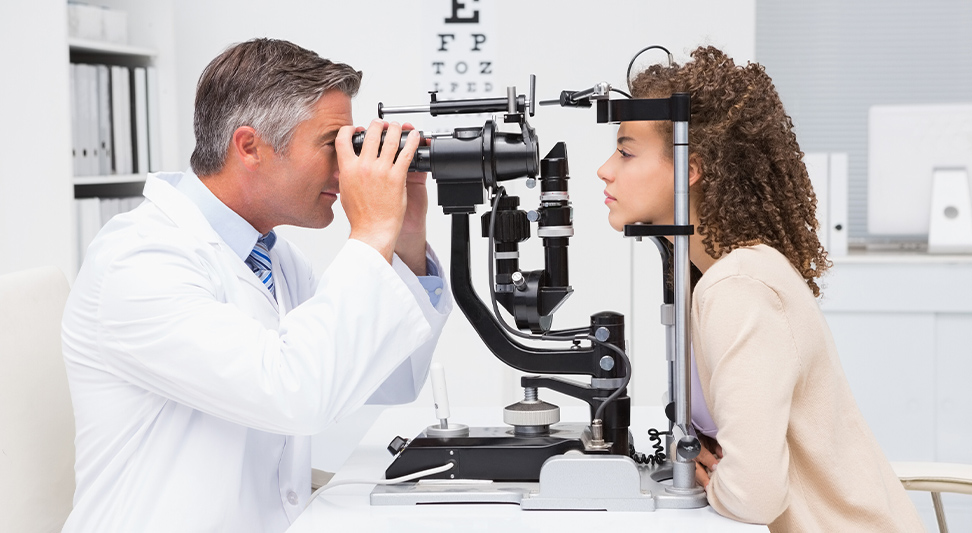If you have been squinting across the room to read the scoreboard or fumbling for your glasses before your morning coffee, you have probably wondered: “Am I a good candidate for LASIK?”
As straightforward as the question sounds, the answer combines science, safety, and personal vision goals. At nJoy Vision, we aim to ensure every prospective patient begins this life‑changing journey with clear expectations and total confidence. It’s one of the reasons why we’re a trusted laser vision correction center for LASIK in OKC.
To help ensure your LASIK journey starts as smoothly as possible, here is a step‑by‑step overview of the candidacy process so that you know what to expect from the moment you book your consultation to the moment you hear those four magic words – “You’re a LASIK candidate!”
Why LASIK Screenings and Consultations Matter

Think of LASIK screening as the architectural blueprint for your laser vision correction. This comprehensive appointment should last an hour or two and is a vital first step, delivering a detailed map of your eyes and peace of mind that LASIK can provide the clear vision you seek.
Just as a builder would never break ground without precise measurements, a LASIK surgeon should never perform laser vision correction without verifying that:
- Your corneas are the right thickness, curvature, and overall health.
- Your prescription has held steady long enough to ensure lasting results.
- There are no underlying eye diseases (like keratoconus or uncontrolled dry eye) that could compromise safety.
- Your prescription falls within the FDA’s approved treatment parameters for LASIK.
- Your lifestyle and expectations align with what LASIK can realistically achieve.
What to Bring To Your LASIK Consultation and How to Prepare
A little preparation turns your consultation and screening appointment into a productive conversation rather than a pop quiz. Before you arrive, gather the following:
- Your current eyeglass & contact lens prescriptions. This information will help us establish the baseline refractive error we need to correct.
- Your complete medical history. Being upfront about medical conditions and medications protects your health and safety. Medical conditions like diabetes, autoimmune disorders, and pregnancy can impact your candidacy, and medications like corticosteroids can delay healing.
- A list of your symptoms. It’s important to inform us of problems like dry eyes, allergies, or night-glare issues that might affect surgical planning or post‑op comfort.
- Your vision goals, lifestyle needs, and expectations. Tell us if you fly planes, coach night games, or work 12‑hour screen shifts. Each job has unique visual demands that we’ll take into consideration when determining your candidacy.
- Personal questions & concerns. Bring a notebook or your Notes app. From technology and safety to financing and recovery time, the consultation is the best place to discuss anything that’s important to you.
The Tests to Expect at Your LASIK Evaluation

A proper LASIK evaluation should use sophisticated, non‑invasive diagnostic tests to determine your candidacy. These tests incorporate high‑powered imaging tools to capture precise details of your eyes to develop a truly personalized treatment plan.
Comprehensive Vision Analysis
This test is much more complex than the standard “which one is better, one or two?” vision screening you’ve done before. Digital analyzers and manual refraction should be used during a comprehensive vision analysis to measure your eye’s ability to focus in multiple ways.
- Pinpoint your exact prescription.
- Assess your overall quality of vision.
- Examine how light refracts as it enters your eye.
- Determine the best vision correction strategy.
Pupil Dilation
Prescription eye drops that gently enlarge your pupils allow us to examine the internal structures of your eye and make additional measurements and refinements.
Advanced Corneal Analysis
The cornea is the front surface of the eye, where laser vision correction happens. High-resolution scans of the cornea provide microscopic detail and data about:
- The curvature and shape of the cornea
- Corneal thickness
- Irregularities on the surface
- Overall corneal health and stability
Retinal Health Assessment
The retina is an important structure at the back of the eye that processes light and sends the visual information to your brain. Determining retinal health is a vital step in successful vision correction outcomes.
Tear Film Evaluation
The tear film is a thin, protective layer of liquid covering the surface of the eye. It plays an important role in overall eye health and proper healing after vision correction surgery. Using state-of-the-art technology, we evaluate your tear film quality to address dry eye symptoms and improve the healing process.
Comprehensive Eye‑Structure Examination
During your screening, an eyecare professional will use high-powered microscopes to examine all the structures of your eye. They should also take additional measurements of eyeball dimensions and pupil size under various lighting conditions. This examination checks for conditions that could impact your LASIK candidacy, including:
- Eye allergies that could make healing more difficult
- Cataracts
- Signs of diabetes or other systemic conditions
- Glaucoma or elevated eye pressure
- Macular degeneration
- Inflammatory conditions
LASIK Eval Red Flags & Potential Concerns
During your LASIK evaluation appointment, we’ll be on the lookout for warning signs that LASIK might not be the right choice for you. Some of those red flags and concerns include:
- Prescription Instability (>0.50D change in 12 months)
- Abnormal Topography (possible early keratoconus)
- Severe Untreated Dry Eye or Blepharitis
- Autoimmune Disorders (e.g., lupus, rheumatoid arthritis)
- Active Pregnancy or Nursing (hormonal fluctuations)
- Unrealistic Expectations (“I never want reading glasses, ever!”)
Spotting these issues early lets us pivot to a safer plan, add pre‑treatment therapies, or, in rare cases, advise against vision correction surgery altogether.
Questions to Cover During Your Consultation Conversation

After testing, you’ll sit down with one of our experienced LASIK professionals to review your screening results, go over your medical history, discuss your vision goals, and address any questions and concerns you might have. You should expect to receive clear, thorough answers to your questions and no high-pressure sales tactics.
Every patient is different, but here are some questions to consider covering during the final step of the consultation.
- Am I a candidate for LASIK?
- Are there LASIK alternatives I should consider?
- Are there any risks or side effects with LASIK I should think about?
- What laser technology will be used for my treatment plan?
- What is the LASIK recovery timeline?
- When can I return to specific activities, e.g., golf, jiu jitsu, gardening?
- What is the cost of LASIK?
- Do you offer any LASIK discounts or promotional savings?
- Does my insurance provide coverage for LASIK or offer discounts?
- What are my LASIK financing options?
Common LASIK FAQs
The best way to get accurate, reliable answers to your LASIK questions is to book a free consultation at nJoy Vision. That said, we know your time is valuable. So, before you start juggling your schedule to add another event to a crammed summer calendar, here are a few rapid-fire responses to the most common LASIK candidacy questions to help you decide whether scheduling a visit makes sense.
Q: Is there an age limit for LASIK?
A: While there isn’t a strict age limit for LASIK, it is most beneficial for people between the ages of 18 and their early 40s. After 40, most people experience natural changes in the eye, like presbyopia (age-related near vision loss). This could mean that LASIK isn’t the best solution on its own. However, excellent surgical options are still available for patients in their 40s and beyond.
Q: Can I have LASIK if I have astigmatism?
A: Yes! LASIK can treat myopia (nearsightedness), hyperopia (farsightedness), and astigmatism. At nJoy Vision, our advanced LASIK technology can correct astigmatism up to the following degrees:
- Up to -5.00 diopters of astigmatism for nearsightedness
- Up to +2.00 diopters of astigmatism for farsightedness
- From 1.00 to 5.00 diopters of mixed astigmatism
Q: How long after consultation can I schedule my LASIK procedure?
A: Most patients book their LASIK procedure within two weeks of their consultation. However, we honor our consultation results for 30 days to help accommodate travel or scheduling conflicts.
Q: Will insurance cover LASIK?
A: Vision insurance rarely pays for LASIK, so we strive to make LASIK as affordable as possible with the following programs and payment options:
- Seasonal promotions like our $600 Summer of LASIK savings.
- Special financing plans that offer $0 down and 0% interest.
- HSA & FSA accounts.
- Vision Care Direct (VCD) and Primary Vision Care Services (PVCS) member savings plans.
- Corporate partner plans.
Start Your Lasik Journey – Find Out If You’re a Lasik Candidate Today
If you’re tired of seeing life through a pair of corrective lenses, a fresh perspective might be closer than you think. And it all starts with a simple question – “Am I a LASIK candidate?”
While you can read all the blog posts, watch all the videos, and do all the research your heart desires, there’s only one guaranteed way to find out 👇
Schedule Your FREE LASIK Consultation at nJoy Vision in OKC
Or call

